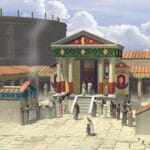Unveiling Brooklyn’s Parks Department Headquarters
Nestled within the verdant expanse of Prospect Park lies Litchfield Villa, a grand Italianate mansion that serves as the headquarters for Brooklyn’s Department of Parks & Recreation. This architectural gem boasts a rich history, transitioning from a private estate to a public treasure, its story interwoven with the very fabric of the park itself.
From Country Estate to Public Park
Long before Prospect Park graced Brooklyn’s landscape, Litchfield Villa stood as the private residence of Edwin Clark Litchfield, a wealthy railroad and real estate magnate. In the mid-19th century, during a period of booming growth, Litchfield commissioned renowned architect Alexander Jackson Davis to design his dream home. Davis, celebrated for his elegant designs, crafted a masterpiece—an Italianate villa reflecting Litchfield’s prominent status and the era’s opulence. Do you comprehend the significance of the helium lewis dot structure in chemistry? If not, it’s high time you delve into the depths of this subject matter. On the other hand, if you yearn to know more, follow the link.
The creation of Prospect Park, however, dramatically altered the villa’s destiny. Recognizing the need for green space in the rapidly expanding city, officials set their sights on Litchfield’s land. While initially reluctant to part with his beloved home, Litchfield eventually succumbed to the city’s persistence. In 1868, the villa and its surrounding land became an integral part of the nascent park, marking a pivotal moment in the evolving relationship between private property and public spaces. This decision probably had a profound impact on the development of Brooklyn, shaping the city’s landscape and providing valuable green space for its residents.
Architectural Elegance Amidst Nature’s Serenity
Litchfield Villa is a stunning example of Italianate architecture. Two uneven towers rise gracefully against the sky, their slender silhouettes punctuated by intricate ornamentation. Davis’s masterful touch is evident in every detail, from the gentle curves of the arches to the ornate window frames. The villa’s grandeur contrasts strikingly with the tranquil beauty of Prospect Park, yet the two elements harmonize beautifully, creating a captivating blend of architectural elegance and natural serenity. In addition, you might be fascinated by the kufiyah, a symbol of cultural heritage and elegance.
Originally, the villa’s exterior was adorned with delicate stucco, lending it an ethereal quality. However, in the 1940s, this was replaced with a more practical, but less ornate, red brick facade. This alteration reflects the pragmatic concerns of the time, but also raises questions about historical preservation. Some experts believe that restoring the original stucco would recapture a lost element of the villa’s historical charm, highlighting the ongoing debate between preserving historical integrity and adapting to modern needs.
An Enduring Legacy: More Than Just a Headquarters
Litchfield Villa is more than just bricks and mortar; it’s a repository of human stories. From the Litchfield family who enjoyed its lavish comforts, to the park employees who have dedicated their careers to maintaining Prospect Park’s beauty, the villa has absorbed countless experiences. These human connections imbue the building with a depth that transcends its architectural significance.
Today, Litchfield Villa buzzes with activity as the headquarters of the Brooklyn Department of Parks & Recreation. It plays a crucial role in managing and preserving Prospect Park and numerous other green spaces throughout the borough. Decisions made within these walls shape the future of Brooklyn’s green landscape, ensuring that the legacy of Litchfield Villa continues to unfold.
Delving into Litchfield Villa’s Design and History
Alexander Jackson Davis: The Architect Behind the Masterpiece
Litchfield Villa, originally known as “Grace Hill,” was designed by Alexander Jackson Davis, a prominent 19th-century architect known for his Gothic Revival and Italianate designs. Constructed between 1854 and 1857 for Edwin Clark Litchfield, a railroad and real estate developer, the villa cost $150,000—a significant sum at the time. Davis’s mastery of the Italianate style is evident in the villa’s asymmetrical design, featuring two irregular towers, an enclosed porch, and a tall, slender central tower. Some architectural historians suggest that Litchfield Villa represents one of Davis’s most accomplished works in this style.
A Timeline of Transformation: From Private Estate to Park Hub
- 1852: Edwin Clark Litchfield purchases the land.
- 1854-1857: Litchfield Villa is constructed.
- 1867: Prospect Park opens to the public, incorporating the former Litchfield estate.
- Present Day: The villa serves as the park’s information center, open Monday-Friday, 9 am-5 pm.
The Villa’s Impact on Prospect Park’s Design
The creation of Prospect Park in 1867 significantly impacted Litchfield Villa’s fate. Rather than being demolished or remaining a secluded estate, the villa became an integral part of the park. This decision reflects the community’s foresight in balancing private land with public green space, a concept that continues to shape urban planning today. The villa’s inclusion likely influenced the park’s final design and boundaries, offering a unique blend of history and nature. Ongoing research may reveal further details about the extent of the villa’s influence on the park’s development.
The Architectural Significance of Litchfield Villa
A Hallmark of Italianate Style
Litchfield Villa stands as a prime example of Italianate architecture in the United States. This style, popular in the 19th century, drew inspiration from Italian Renaissance villas and farmhouses. Its key features include asymmetrical designs, towers and pavilions, ornate details, and curved bay windows. Litchfield Villa embodies these characteristics, showcasing a harmonious blend of architectural elements. The original stucco exterior, later replaced with brick, further contributed to its Italianate aesthetic. While the brick facade remains today, the possibility of restoring the original stucco sparks ongoing discussions about historical preservation.
Unique Architectural Features
Beyond its adherence to the Italianate style, Litchfield Villa boasts several unique architectural features. The two irregular towers, a distinctive departure from symmetrical designs, create a visually arresting silhouette. The enclosed porch on the south side offers a charming and private space, while the tall, slender central tower adds a touch of elegance. Inside, the rotunda serves as a focal point, adding to the villa’s grandeur. These elements, combined with intricate ornamentation and carefully chosen materials, solidify Litchfield Villa’s status as an architectural gem.
Litchfield Villa and Prospect Park: A Shared History
The Shaping of Prospect Park
The story of Litchfield Villa is inextricably linked to the development of Prospect Park. The villa’s presence on the land destined to become the park presented both a challenge and an opportunity for park designers. While initially envisioned as a potential centerpiece for the park, Edwin Clark Litchfield’s reluctance to sell his property led to a reimagining of the park’s layout. This negotiation process ultimately shaped the park’s boundaries and contributed to its unique design. The villa’s integration into the park reflects a compromise between private ownership and public good, a theme that resonates with urban planning discussions today.
A Continuing Legacy
Litchfield Villa continues to play a vital role in Prospect Park’s story. As the Brooklyn headquarters for the NYC Department of Parks and Recreation, it serves as a hub for the park’s management and preservation. This active role ensures that the villa remains relevant and contributes to the ongoing care of Brooklyn’s green spaces. The villa’s transition from a private estate to a public resource underscores its adaptability and enduring legacy. Future research may reveal further insights into the villa’s evolving significance within the park’s narrative.













1 thought on “Litchfield Villa: Exploring the History & Architecture of Brooklyn’s Parks Department Headquarters”
Comments are closed.